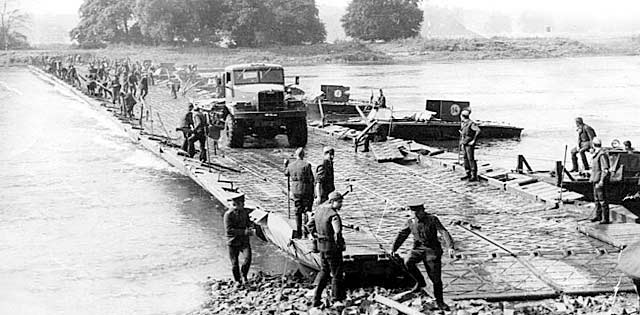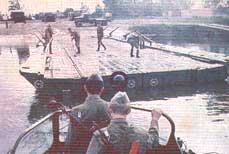Soviet Army.
|
|||||||||||||||||||||||
| Bridge carrying capaciry | Road width (m.) | Maximum length of the bridge (m.) | Time needed for installation (min.) |
| 60 20 |
6.59 3.29 |
227 382 |
30 50 |
PMP ferries basic characteristics:
| Ferry carrying capacity (t.) | Amount of ferries made of PBC units | Number of sections needed per a ferry, units | Length of the ferry (m.) | Time needed for installation (min.) | |
| floating | abutment | ||||
| 40 60 80 130 170 |
16 10 8 4 4 |
2 3 4 6 8 |
- - - 1 1 |
13.5 20.25 27.0 46.0 59.5 |
8 10 12 13-15 16-20 |
Pontoon-bridging column PMP is full equipment for bridging through water obstacles . Since1962 the Soviet Army was armed with this type of PMP .
This equipment may be used for as a ferry to carry people
and equipment through water obstacles. Besides PMP may include vehicles to
transport equipment. The standard set of equipment allows to construct
bridges of different length and carrying capacity.
The bridge length may be up to 227 m for 60 ton cargo; or up to 382 m for 20
ton cargo. Permissible current flow is up to 2.5 m/sec. The pontoons upper
part is used as a road.
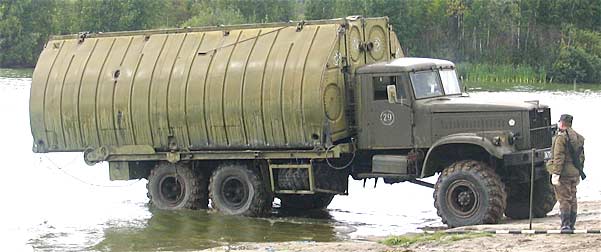 The PMP includes 32 floating sections, 4 abutment sections, 2 road covers,
12 tugboats. The transportation of the sections is performed by 38 KrAZ-255B
trucks equipped with special devices. The boats BMK-90, BMK-130 or
BMK-150 are tugged by ZIl-130(ZIL-157) trucks with the help of a trailer or
their own wheels . If PBC contains BMK-T boats; they are transported on 12 KrAZ-255B
trucks platforms.
The PMP includes 32 floating sections, 4 abutment sections, 2 road covers,
12 tugboats. The transportation of the sections is performed by 38 KrAZ-255B
trucks equipped with special devices. The boats BMK-90, BMK-130 or
BMK-150 are tugged by ZIl-130(ZIL-157) trucks with the help of a trailer or
their own wheels . If PBC contains BMK-T boats; they are transported on 12 KrAZ-255B
trucks platforms.
The KraZ truck carries one section, which includes two middle and two edge pontoons. The pontoons are connected by hinges. For transportation the section is folded up on the truck platform. The picture displays the truck with a floating section. Next picture is the back view of the truck with the section containing two middle right-angled pontoons and two edge curved pontoons. The abutment section is different from the floating section. Due to its form the abutment section allows to connect the bridge with the bank, besides, the section has folding devices so that cars could go down the bridge to the bank.
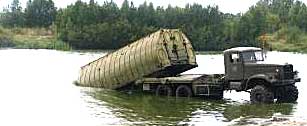 The section crew should consist of a driver and
two pontooneers. It can also consist of a driver-pontooneer and a
pontooneer. The procedure of installing the bridge or a ferry is as follows:
the truck moves backward into the water up to the point where the depth is
not less than 1 m; then the truck brakes abruptly; the pontooneer releases
the hold; the section released rolls down the platform into the water
easily.
The section crew should consist of a driver and
two pontooneers. It can also consist of a driver-pontooneer and a
pontooneer. The procedure of installing the bridge or a ferry is as follows:
the truck moves backward into the water up to the point where the depth is
not less than 1 m; then the truck brakes abruptly; the pontooneer releases
the hold; the section released rolls down the platform into the water
easily.
 In the water the section spreads under the
influence of floatation powers with the help of hinges. In the picture the
section is in the process of spreading (back view). At the moment the
section is being hold by a mooring rope from the bank. The other edge of the
rope is fixed on the truck. The driver-pontooneer and the pontooneer go up
to the deck, lock the bottom and the deck to make the section construction
rigid.
In the water the section spreads under the
influence of floatation powers with the help of hinges. In the picture the
section is in the process of spreading (back view). At the moment the
section is being hold by a mooring rope from the bank. The other edge of the
rope is fixed on the truck. The driver-pontooneer and the pontooneer go up
to the deck, lock the bottom and the deck to make the section construction
rigid.
 In the picture the section is spread (back
view). After the deck and bottom are locked the pontooneers bring the
sections closer to each other using hooks and lock the sections together.
Thus the bridge line is being assembled along the bank. During the procedure
the section is hold by mooring ropes fixed on the truck on the bank. As soon
as the section is assembled the truck throws the mooring rope and leaves the
site. The road width is 6.5 m.
In the picture the section is spread (back
view). After the deck and bottom are locked the pontooneers bring the
sections closer to each other using hooks and lock the sections together.
Thus the bridge line is being assembled along the bank. During the procedure
the section is hold by mooring ropes fixed on the truck on the bank. As soon
as the section is assembled the truck throws the mooring rope and leaves the
site. The road width is 6.5 m.
The assembled bridge line is turned around and placed
across the river; the abutment sections are fixed at the bridge by mooring
ropes. The bridge line is kept by
 tugboats until anchors are fixed on each
section and dropped. After the anchor ropes are stretched and the bridge
line is even, the tugboats leave. This is a part of the bridge line in the
picture (view from above). The dark green part is the road 6.5 m wide. Such
road width allows the tanks to move at 30 km/h and vehicles have no speed
limit. Besides the vehicles can move in two columns or in opposite
directions along the road simultaneously. This installation scheme makes it
possible to construct a bridge 227 m long with carrying capacity 60 ton out
of one set of equipment of the previously described type.
tugboats until anchors are fixed on each
section and dropped. After the anchor ropes are stretched and the bridge
line is even, the tugboats leave. This is a part of the bridge line in the
picture (view from above). The dark green part is the road 6.5 m wide. Such
road width allows the tanks to move at 30 km/h and vehicles have no speed
limit. Besides the vehicles can move in two columns or in opposite
directions along the road simultaneously. This installation scheme makes it
possible to construct a bridge 227 m long with carrying capacity 60 ton out
of one set of equipment of the previously described type.
The installation scheme is different for 20 ton cargo
bridge. The section is disconnected at one side; 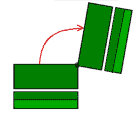 then the section is
turned around at 180 degrees angle. In this case the bridge line looks as
follows: the first section is in a usual position - the second section is
turned aro
then the section is
turned around at 180 degrees angle. In this case the bridge line looks as
follows: the first section is in a usual position - the second section is
turned aro und - the
next section is in a usual position - and so on. The road width is 3.3 m,
and it’s possible to construct 382 m long bridge out of one set of
equipment.
und - the
next section is in a usual position - and so on. The road width is 3.3 m,
and it’s possible to construct 382 m long bridge out of one set of
equipment.
The road cover is a metal coated tape. It consists of detached sections connected with each other by hinges. The tape covers KraZ trucks platforms. The road cover is used to make it possible for the vehicles to get on the bridge from marshy ground.
The notice of the writer. American engineers made
a mere copy of our PMP for their army in 1972. The only difference was that
they used duralumin instead of steel for pontoons and installed them on
American trucks. They even used the same number of bolts on hatches leading
inside pontoons.
The Czechoslovak Republic got a license for PMP production, the Czech
engineers installed the pontoons on their four-axed trucks Tatra.
The bridge line may consist of as many sections as you wish. It’s possible
to make a 430-metres bridge if you use two PBC complete sets of equipment.
However it’s expedient to use ferries if the water obstacle is extremely
wide.
Bibliography:
1.Инструкция по материальной части и эксплуатации
понтонно-мостового парка ПМП . Военное издательство МО СССР. Москва 1966г.
2.Военно-инженерная подготовка. Учебное пособие. Военное издательство
Министерства обороны СССР. Москва. 1982г.
3.Понтонно-мостовой парк ПМП. Руководство по материальной части и
применению. Военное издательство Москва 1981г.
---***---
©Веремеев Ю.Г.
Главная страница
-инженерная техника
